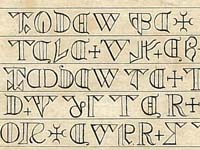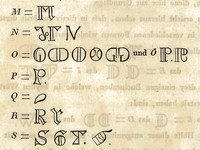Random ornaments? - The Heilsberg inscription
|
[Joseph von Hammer-Purgstall:] Die Inschrift von Heilsberg. Weimar 1818. - Jena : gedruckt bey Frommann und Wesselhöft, 1818. Austrian National Library, shelfmark: 309.710-D.Alt-Mag In 1816, Goethe’s brother-in-law Chr. A Vulpius draw the poet’s interest to an enigmatic medieval stone inscription mounted at the wall of the church of Heilsberg (today part of Remda-Teichel, Thuringia). Contacted through Austrian chancellor Metternich, the orientalist and diplomat Joseph von Hammer-Purgstall jumped at the task of deciphering the script with all the enthusiasm characteristic of his nature. Goethe, whose “West-Östlicher Diwan” had been greatly inspired by Hammers renderings of Persian poetry into German, seamed at first ready to accept Hammer’s interpretation of the text as “highly extraordinary as well as plausible” and undertook its publication, though not without some doubts: “The celebrated Heilsberg inscription I get printed with an explanation by Von Hammer, which however does not come off happily” (Truth and Poetry, annals 1817). Hammer had dated the central inscription on the stone plate to the 9th century A.D. According to his view, the text was written in Old High German, with emperor Ludovic I. granting some privilege to the abbey of Heilsberg by oath. The surrounding text on the margin he identified as a Latin funeral inscription for emperor Lothar II. (d. 1137 in the Tyrol). When Ulrich Friedrich Kopp, jurist and expert on German medieval palaeography, published a sharp critique, invalidating Hammer’s arguments by linguistic and historical points and not sparing the sarcasm, Goethe had to admit that the “lettermaster’s reasons” were strong. He wrote to Georg Friedrich Grotefend, the famous first decipherer of cuneiform texts, asking for his opinion. Grotefend’s judgement was somehow milder than Kopp’s, but still refuted most of Hammer’s arguments. None of these scholars, however, would undertake a translation, and until today the Heilsberg inscription remains an unsolved mystery. This beautiful print of Hammer’s interpretation shows the Heilsberg inscription on the title page and an “alphabet” of the script, compiled by Hammer, on page 2. All characters Hammer was unable to class were curtly labelled “random ornaments” or “distinguishing signs”. The print bears a dedication to Metternich, dated April 7th, 1817. (Klick on image teasers to view full image.) |



